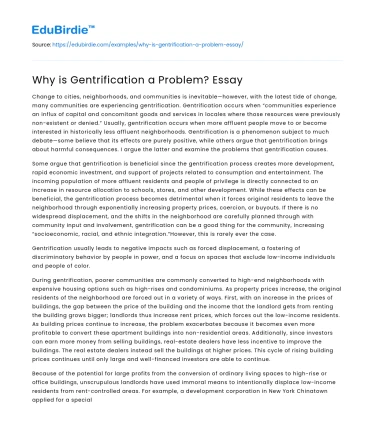Change to cities, neighborhoods, and communities is inevitable—however, with the latest tide of change, many communities are experiencing gentrification. Gentrification occurs when “communities experience an influx of capital and concomitant goods and services in locales where those resources were previously non-existent or denied.” Usually, gentrification occurs when more affluent people move to or become interested in historically less affluent neighborhoods. Gentrification is a phenomenon subject to much debate—some believe that its effects are purely positive, while others argue that gentrification brings about harmful consequences. I argue the latter and examine the problems that gentrification causes.
Some argue that gentrification is beneficial since the gentrification process creates more development, rapid economic investment, and support of projects related to consumption and entertainment. The incoming population of more affluent residents and people of privilege is directly connected to an increase in resource allocation to schools, stores, and other development. While these effects can be beneficial, the gentrification process becomes detrimental when it forces original residents to leave the neighborhood through exponentially increasing property prices, coercion, or buyouts. If there is no widespread displacement, and the shifts in the neighborhood are carefully planned through with community input and involvement, gentrification can be a good thing for the community, increasing “socioeconomic, racial, and ethnic integration.”However, this is rarely ever the case.
Save your time!
We can take care of your essay
- Proper editing and formatting
- Free revision, title page, and bibliography
- Flexible prices and money-back guarantee
Gentrification usually leads to negative impacts such as forced displacement, a fostering of discriminatory behavior by people in power, and a focus on spaces that exclude low-income individuals and people of color.
During gentrification, poorer communities are commonly converted to high-end neighborhoods with expensive housing options such as high-rises and condominiums. As property prices increase, the original residents of the neighborhood are forced out in a variety of ways. First, with an increase in the prices of buildings, the gap between the price of the building and the income that the landlord gets from renting the building grows bigger; landlords thus increase rent prices, which forces out the low-income residents. As building prices continue to increase, the problem exacerbates because it becomes even more profitable to convert these apartment buildings into non-residential areas. Additionally, since investors can earn more money from selling buildings, real-estate dealers have less incentive to improve the buildings. The real estate dealers instead sell the buildings at higher prices. This cycle of rising building prices continues until only large and well-financed investors are able to continue.
Because of the potential for large profits from the conversion of ordinary living spaces to high-rise or office buildings, unscrupulous landlords have used immoral means to intentionally displace low-income residents from rent-controlled areas. For example, a development corporation in New York Chinatown applied for a special zoning permit for the construction of an apartment on a plot with rent-control housing; before the city decided whether or not to issue the permit, the developer had already evicted the tenants and demolished the rent-controlled building. The residents stated that the corporation forced them out of the building through deprivation of services, harassment, gang intimidation, and arson.
Even when the living spaces in a gentrifying area remain residential, the developers attract new residents with higher incomes because of the services and amenities that improve in conjunction with the increase cost of living and property values. The influx of these new and more affluent residents puts pressure on the housing market that produce inflated rents and prices that effectively displace low-income residents. Furthermore, during rezoning, the new residents, who are in the groups with the “most spatialized privilege” and “high economic [standing, have] the power to shape city policy to protect themselves from further gentrification that might have priced them out of the area.'
Displacement from these aforementioned methods is disproportionately borne by low-income individuals of color, many of whom are elderly individuals. Physical frailty makes it more challenging for elderly individuals to resist the actions that landlords take to remove tenants. Researchers have also found that elderly people are more intensively affected by social changes around them; for example, many older adults cited loss of friendships or community networks as a reason to move. This is a problem that builds on itself— with gentrification, many people are rapidly forced out of their neighborhoods, leading to less community networks and more reason for elderly low-income individuals, who are already facing struggles from rising prices, to give up on their homes and move out of the neighborhood.
In addition to displacement due to rising property values and coercive techniques, low-income individuals and people of color also can face exclusion from the newly planned spaces in the gentrifying location. Common in gentrification efforts is the urban planning shift from “fostering community formation” to “investing the city with money and consumption-oriented spaces that resemble suburban shopping malls that exclude low-income and people of color.” Instead of community integration, there is selective development and enforcement of distinction between different areas. Moreover, when developers do build houses, they are not building these houses for low income families. There are frequent cuts in low-income housing federal assistance, and so new buildings are usually intended for upper-income families. These spaces are societally problematic because they disproportionately exclude people of color and low-income individuals.
Most gentrification occurs because of a lack of policies that value community input, offer equitable rezoning policies, and provide intentional housing options. Without policies that attempt to remedy the trends that cause forced displacement, gentrification will continue to dismantle and displace lower-income communities. To develop such policies, we must recognize the disproportionate and destructive effects of gentrification.






 Stuck on your essay?
Stuck on your essay?

